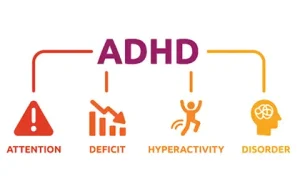Overview
Diagnosis
ADHD is usually diagnosed when core symptoms begin before age 12 and consistently cause problems at home and school. There is no single test for ADHD; diagnosis typically involves a combination of:
Medical exam
Helps rule out other causes of symptoms, such as sleep disorders, vision or hearing problems, or medical conditions.
Information gathering
Includes reviewing medical history, family history, school records, and current health conditions.
Interviews and surveys
Parents, teachers, caregivers, and other adults who know the child well provide input on behaviors in different settings.
ADHD rating scales
Standardized tools to collect and evaluate information about the child’s behavior.
Diagnosing ADHD in young children
Preschoolers or younger children suspected of ADHD often need evaluation by a specialist (psychologist, psychiatrist, developmental pediatrician, or speech pathologist).
Other conditions with similar symptoms
-
Learning or language delays
-
Mood disorders (depression)
-
Anxiety disorders
-
Seizure disorders
-
Autism spectrum disorder
-
Brain injury
-
Medical conditions or medications affecting behavior
Treatment
ADHD treatment focuses on managing symptoms rather than curing the condition. A combination of medications, behavior therapy, counseling, and educational support is often most effective.
Stimulant Medicines
Stimulants are the most commonly prescribed ADHD medications and work by boosting and balancing brain chemicals called neurotransmitters. They reduce inattention and hyperactivity.
Examples include:
-
Amphetamines: dextroamphetamine (Dexedrine), dextroamphetamine-amphetamine (Adderall XR, Mydayis), lisdexamfetamine (Vyvanse)
-
Methylphenidates: methylphenidate (Concerta, Ritalin), dexmethylphenidate (Focalin), dexmethylphenidate-serdexmethylphenidate (Azstarys)
Forms: Short-acting, long-acting, and patches (e.g., Daytrana, Xelstrym).
Safety and side effects:
-
May affect heart rate, blood pressure, appetite, and growth
-
Rare mental health side effects such as irritability or mania
Nonstimulant Medicines
FDA-approved options:
-
Atomoxetine (Strattera)
-
Viloxazine (Qelbree)
-
Guanfacine (Intuniv)
-
Clonidine (Onyda XR)
Other options: Antidepressants like bupropion may be used if stimulants or nonstimulants are unsuitable.
Notes: These medicines often take weeks to show full effects. Some may carry a slight risk of suicidal thoughts, requiring careful monitoring.
ADHD Behavior Therapy
Therapy is often combined with medications for better outcomes.
Types of therapy:
-
Behavior therapy: Strategies for parents and teachers to manage behavior
-
Social skills training: Helps children learn appropriate social behaviors
-
Parenting skills training: Guidance for managing child behavior effectively
-
Talk therapy/psychotherapy: Supports emotional processing in older children
-
Family therapy: Helps families manage challenges related to ADHD
Medical Devices
FDA-approved devices for children with ADHD:
-
Monarch external trigeminal nerve stimulation (eTNS): For children 7–12 not taking medication
-
EndeavorRx: A game-based device for children 8–17 with inattentive or combined-type ADHD
Note: These devices are relatively new, with limited long-term data. Consultation with a healthcare professional is essential.
Ongoing Treatment and Monitoring
Children with ADHD should have regular follow-ups every 3–6 months. Contact the healthcare professional if:
-
Side effects appear (e.g., appetite loss, sleep trouble, irritability)
-
ADHD symptoms persist or worsen
Advertisement

